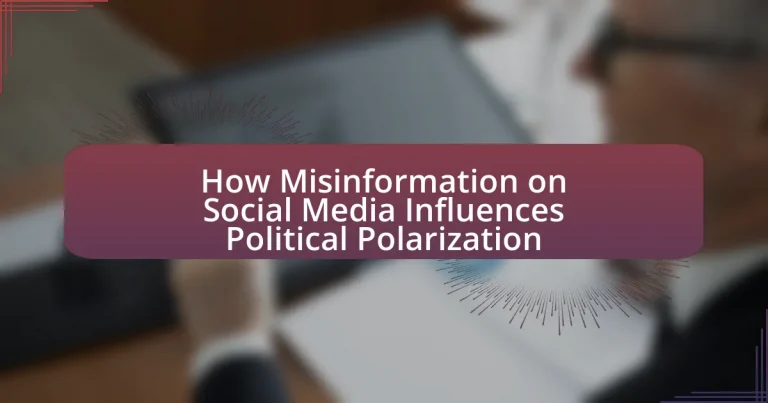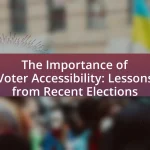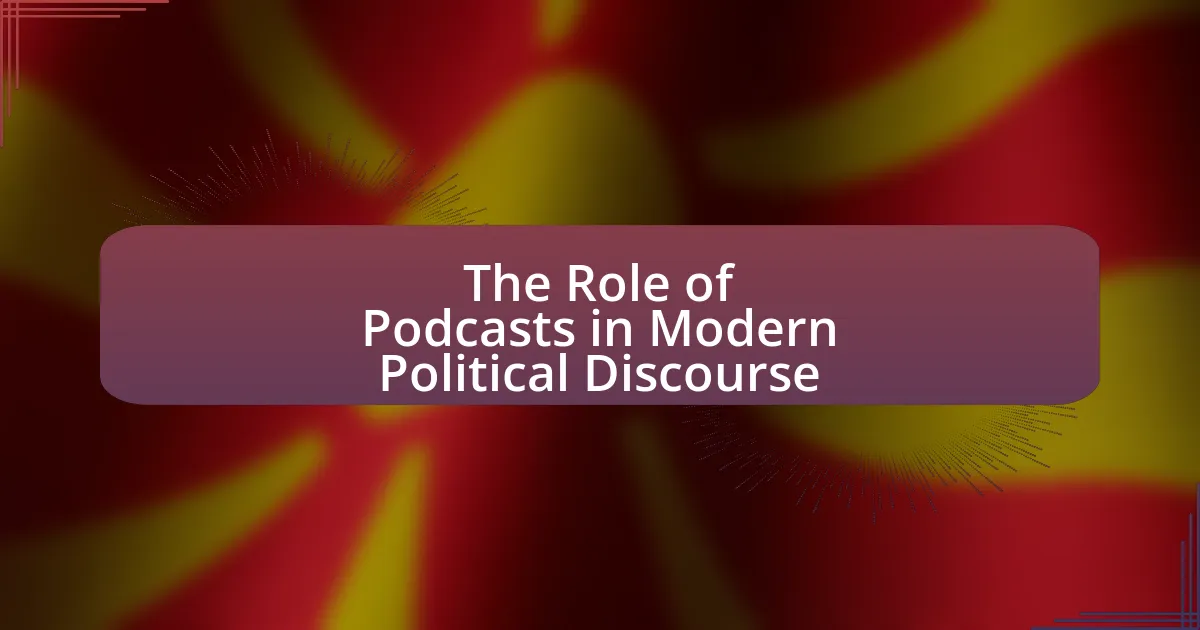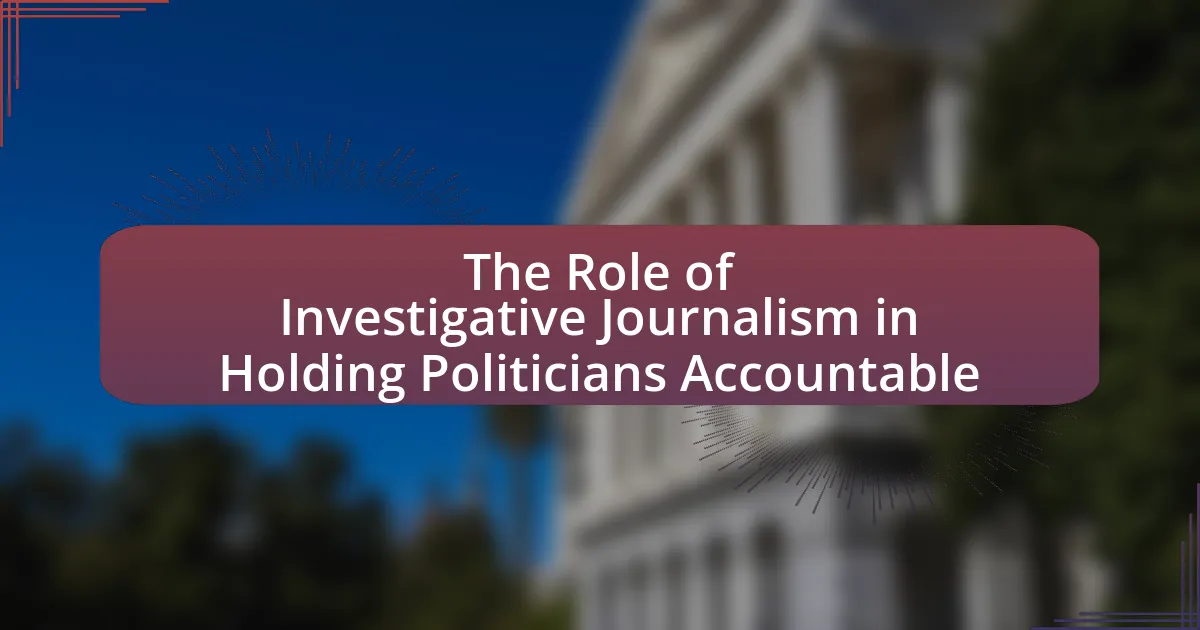The article examines how misinformation on social media contributes to political polarization by reinforcing biases and creating echo chambers. It outlines the mechanisms through which misinformation spreads, including algorithmic amplification and user interactions, and discusses the psychological factors that make individuals susceptible to false narratives. The impact of misinformation on public perception, voter behavior, and democratic processes is analyzed, highlighting the consequences of increased polarization on societal trust and community relationships. Strategies for mitigating misinformation’s influence, such as media literacy education and collaboration between platforms and fact-checkers, are also explored.

How does misinformation on social media contribute to political polarization?
Misinformation on social media significantly contributes to political polarization by reinforcing existing biases and creating echo chambers. When individuals encounter false or misleading information that aligns with their pre-existing beliefs, they are more likely to accept it as truth, which intensifies their ideological stance. Research indicates that exposure to misinformation can lead to increased partisan hostility; for example, a study published in the journal “Political Communication” found that individuals who consume partisan misinformation are more likely to express negative feelings toward opposing political groups. This cycle of misinformation and confirmation bias fosters division, as users become isolated within their ideological bubbles, further entrenching political polarization.
What are the mechanisms through which misinformation spreads on social media?
Misinformation spreads on social media primarily through algorithms that prioritize engagement, emotional content, and user interactions. These algorithms amplify sensational or misleading information because it generates more likes, shares, and comments, leading to a wider reach. Research indicates that false information spreads faster than true information on platforms like Twitter, with a study by Vosoughi, Roy, and Aral (2018) showing that false news stories are 70% more likely to be retweeted than true ones. Additionally, echo chambers and filter bubbles contribute to the spread, as users are often exposed to information that aligns with their existing beliefs, reinforcing misinformation. This phenomenon is further exacerbated by the rapid sharing capabilities of social media, where users can disseminate content without verifying its accuracy, leading to widespread acceptance of false narratives.
How do algorithms influence the dissemination of misinformation?
Algorithms significantly influence the dissemination of misinformation by prioritizing content that generates high engagement, often amplifying sensational or misleading information. Social media platforms utilize algorithms to analyze user behavior, promoting posts that receive more likes, shares, and comments, regardless of their factual accuracy. Research by Vosoughi, Roy, and Aral in the journal Science found that false news spreads more rapidly and widely than true news on Twitter, primarily due to algorithmic amplification. This mechanism creates echo chambers, where users are repeatedly exposed to similar viewpoints, reinforcing political polarization and misinformation.
What role do user interactions play in the spread of misinformation?
User interactions significantly amplify the spread of misinformation by increasing visibility and engagement with false content. When users like, share, or comment on misleading posts, they create a feedback loop that enhances the reach of that misinformation, often leading to viral dissemination. Research indicates that misinformation spreads faster and more widely than factual information on social media platforms, with a study published in Science by Vosoughi, Roy, and Aral in 2018 demonstrating that false news stories are 70% more likely to be retweeted than true stories. This interaction-driven amplification contributes to political polarization by reinforcing existing beliefs and creating echo chambers where users are exposed primarily to information that aligns with their views.
Why is misinformation particularly impactful in political contexts?
Misinformation is particularly impactful in political contexts because it can shape public opinion and influence electoral outcomes. Political misinformation often exploits emotional triggers, leading individuals to form strong, polarized beliefs based on false narratives. Research indicates that misinformation spreads rapidly on social media platforms, with studies showing that false information is 70% more likely to be retweeted than true information. This rapid dissemination can create echo chambers, reinforcing existing biases and deepening political divides. Furthermore, misinformation can undermine trust in democratic institutions and processes, as evidenced by the 2016 U.S. presidential election, where false claims significantly affected voter perceptions and behaviors.
How does misinformation shape public perception of political issues?
Misinformation significantly shapes public perception of political issues by distorting facts and creating false narratives. This distortion leads individuals to form opinions based on inaccurate information, which can reinforce existing biases and deepen political polarization. Research indicates that exposure to misinformation can alter beliefs about political candidates and policies, as seen in studies like the one conducted by the Pew Research Center, which found that 64% of Americans believe fabricated news stories cause confusion about basic facts. Consequently, misinformation not only misguides public understanding but also influences voting behavior and civic engagement, ultimately impacting democratic processes.
What psychological factors make individuals susceptible to misinformation?
Individuals are susceptible to misinformation due to cognitive biases, emotional responses, and social influences. Cognitive biases, such as confirmation bias, lead individuals to favor information that aligns with their pre-existing beliefs, making them more likely to accept misinformation that supports their views. Emotional responses, particularly fear and anger, can enhance the persuasive power of misinformation, as emotionally charged content is more memorable and shareable. Social influences, including groupthink and the desire for social acceptance, can further reinforce the acceptance of misinformation, as individuals may conform to the beliefs of their social circles. Research indicates that these psychological factors significantly contribute to the spread and acceptance of misinformation, particularly in politically polarized environments.

What are the consequences of political polarization fueled by misinformation?
Political polarization fueled by misinformation leads to increased societal division and a breakdown in civil discourse. This division manifests in heightened animosity between opposing political groups, resulting in reduced willingness to engage in constructive dialogue. Research indicates that misinformation can distort perceptions of reality, causing individuals to cling to extreme viewpoints and reject opposing information, as evidenced by a study published in the journal “Nature” which found that exposure to false information significantly influenced political attitudes. Furthermore, political polarization can undermine democratic processes, as polarized groups may prioritize party loyalty over factual accuracy, leading to challenges in governance and policy-making.
How does political polarization affect democratic processes?
Political polarization undermines democratic processes by creating divisions that hinder consensus-building and compromise. When citizens are deeply divided along ideological lines, it becomes increasingly difficult for elected officials to collaborate on policy-making, leading to legislative gridlock. Research indicates that heightened polarization correlates with increased partisanship in Congress, resulting in fewer bipartisan initiatives and a decline in effective governance. For instance, a study by the Pew Research Center found that in 2016, 55% of Democrats and 49% of Republicans viewed the opposing party as a threat to the nation’s well-being, illustrating how polarization can foster animosity and reduce the willingness to engage in constructive dialogue. This environment can also lead to voter disengagement and decreased trust in democratic institutions, further eroding the foundations of democracy.
What impact does polarization have on voter behavior and engagement?
Polarization significantly impacts voter behavior and engagement by increasing partisan loyalty and reducing cross-party interactions. As individuals align more closely with their political affiliations, they tend to engage more actively in political processes, such as voting and campaigning, often driven by a heightened sense of identity and urgency. Research indicates that during polarized periods, voter turnout can increase, as seen in the 2016 U.S. presidential election, where turnout reached 61.4%, partly due to heightened partisan divides. Additionally, polarization can lead to echo chambers, where voters are less exposed to opposing viewpoints, further entrenching their beliefs and engagement levels. This dynamic creates a feedback loop, reinforcing partisan divisions and influencing how voters perceive information, particularly misinformation spread through social media platforms.
How does polarization influence legislative effectiveness?
Polarization significantly reduces legislative effectiveness by creating deep divisions between political parties, leading to gridlock and decreased collaboration. When legislators are polarized, they are less likely to compromise on policy issues, resulting in fewer bills being passed and a slowdown in the legislative process. Research indicates that during periods of high polarization, such as in the U.S. Congress since the 1990s, the number of bipartisan bills has sharply declined, illustrating how ideological divides hinder effective governance.
What social implications arise from increased political polarization?
Increased political polarization leads to social fragmentation, where communities become divided along ideological lines. This division can result in reduced social cohesion, as individuals are less likely to engage with those holding opposing views, fostering an environment of distrust and hostility. Research indicates that heightened polarization correlates with increased instances of social conflict and decreased willingness to compromise, as seen in studies by Pew Research Center, which found that 73% of Americans believe that political disagreements have become more intense in recent years. Additionally, polarization can undermine democratic processes, as it may lead to voter apathy or disengagement, further exacerbating the divide.
How does polarization affect social cohesion and community relationships?
Polarization negatively affects social cohesion and community relationships by creating divisions among individuals based on differing beliefs and values. This division leads to decreased trust and increased hostility between groups, which can manifest in reduced collaboration and communication. Research indicates that communities experiencing high levels of polarization often see a decline in civic engagement and social networks, as individuals become more isolated within their ideological bubbles. For instance, a study by Pew Research Center found that 73% of Americans believe that political disagreements have increased over the past few years, contributing to a more fragmented society where individuals are less likely to engage with those holding opposing views.
What are the long-term effects of polarization on societal trust?
Long-term effects of polarization on societal trust include a significant decline in trust among individuals and institutions. As polarization intensifies, individuals increasingly view those with opposing viewpoints as adversaries, leading to a breakdown in social cohesion and mutual respect. Research indicates that heightened polarization correlates with decreased trust in government, media, and community organizations, as people become more skeptical of information sources perceived as biased. For instance, a study by Pew Research Center found that in 2020, 61% of Americans believed that political divisions were harming the country, reflecting a broader erosion of trust in societal institutions. This decline in trust can perpetuate a cycle of polarization, as individuals retreat into echo chambers, further isolating themselves from diverse perspectives and reinforcing their biases.
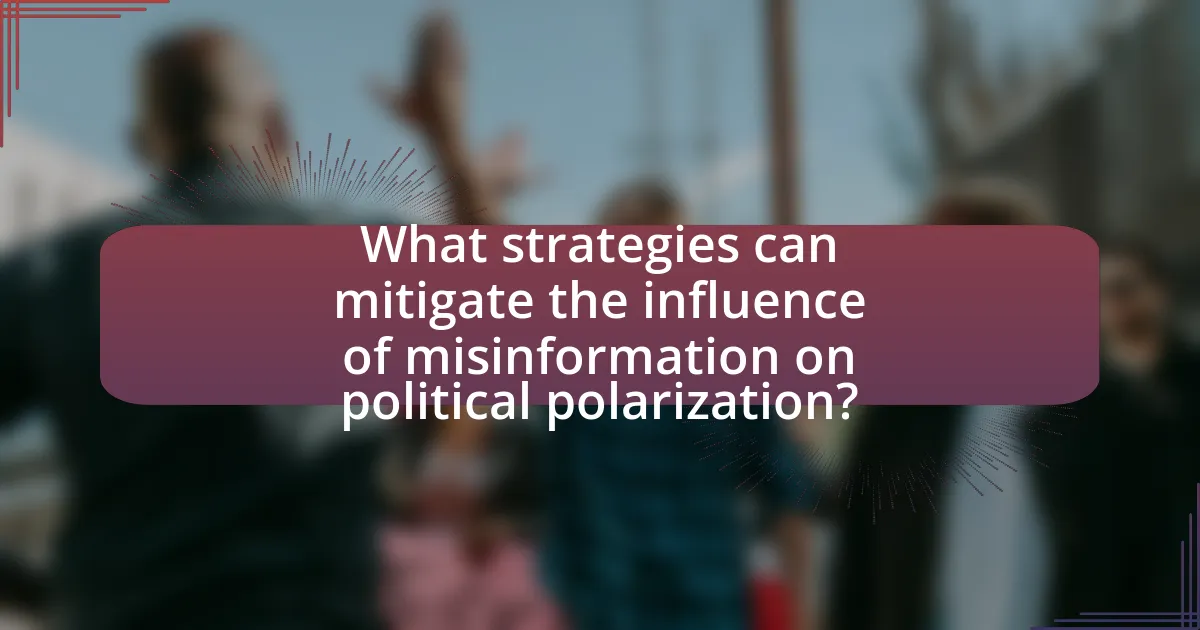
What strategies can mitigate the influence of misinformation on political polarization?
To mitigate the influence of misinformation on political polarization, implementing media literacy programs is essential. These programs educate individuals on how to critically evaluate information sources, recognize biases, and discern factual content from misinformation. Research indicates that media literacy can significantly reduce susceptibility to false information, as demonstrated in a study by the Stanford History Education Group, which found that students who received media literacy training were better at identifying credible sources. Additionally, promoting fact-checking initiatives can help counter misinformation by providing accurate information in real-time, as evidenced by the success of organizations like Snopes and FactCheck.org in debunking false claims. Lastly, fostering open dialogue and encouraging diverse viewpoints can create a more informed electorate, reducing the divisive effects of misinformation on political beliefs.
How can individuals critically evaluate information on social media?
Individuals can critically evaluate information on social media by verifying the credibility of sources, checking for corroborating evidence, and analyzing the content for bias. To verify credibility, individuals should assess the author’s qualifications, the publication’s reputation, and the presence of citations or references. For corroborating evidence, cross-referencing information with reputable news outlets or academic sources can help confirm accuracy. Additionally, analyzing content for bias involves recognizing emotional language, identifying the intended audience, and considering the context in which the information is presented. Research indicates that individuals who engage in these practices are less likely to fall victim to misinformation, thereby reducing the impact of political polarization influenced by false narratives on social media.
What tools and resources are available for fact-checking information?
Fact-checking tools and resources include websites like Snopes, FactCheck.org, and PolitiFact, which provide verified information on various claims. These platforms utilize a team of researchers and journalists to investigate the accuracy of statements made in public discourse, particularly in political contexts. For instance, Snopes has been operational since 1994 and has debunked thousands of myths and misinformation, making it a reliable source for verifying claims. Additionally, browser extensions like NewsGuard and tools such as Google Fact Check Explorer allow users to assess the credibility of news sources and specific articles, further aiding in the identification of misinformation.
How can media literacy education help combat misinformation?
Media literacy education can effectively combat misinformation by equipping individuals with critical thinking skills necessary to analyze and evaluate information sources. This education fosters an understanding of how to identify credible sources, discern bias, and recognize persuasive techniques used in media. Research indicates that individuals who receive media literacy training are better at distinguishing between factual information and misinformation, as evidenced by a study published in the Journal of Media Literacy Education, which found that participants improved their ability to evaluate news content after completing a media literacy program. By enhancing these skills, media literacy education empowers individuals to make informed decisions and reduces the spread of false information, thereby mitigating its impact on political polarization.
What role do social media platforms play in addressing misinformation?
Social media platforms play a crucial role in addressing misinformation by implementing fact-checking mechanisms, content moderation policies, and user education initiatives. These platforms, such as Facebook and Twitter, have developed partnerships with independent fact-checkers to verify the accuracy of information shared on their sites, thereby reducing the spread of false narratives. For instance, Facebook reported that its fact-checking efforts led to a significant decrease in the visibility of false information, with a 50% reduction in engagement on flagged posts. Additionally, social media companies have introduced algorithms designed to prioritize credible sources and limit the reach of misleading content. These actions are essential in combating misinformation, as studies indicate that misinformation can exacerbate political polarization, influencing public opinion and behavior.
What policies can platforms implement to reduce the spread of misinformation?
Platforms can implement policies such as fact-checking partnerships, content labeling, and algorithm adjustments to reduce the spread of misinformation. Fact-checking partnerships with independent organizations can help verify the accuracy of information before it is widely disseminated, as seen in initiatives by Facebook and Twitter, which have collaborated with fact-checkers to assess the credibility of posts. Content labeling can inform users when information is disputed or lacks verification, thereby encouraging critical evaluation of sources. Additionally, algorithm adjustments can prioritize credible sources and reduce the visibility of misinformation, as demonstrated by YouTube’s efforts to promote authoritative content in search results. These strategies collectively aim to create a more informed user base and mitigate the impact of misinformation on political polarization.
How can collaboration between platforms and fact-checkers enhance credibility?
Collaboration between platforms and fact-checkers enhances credibility by ensuring that information disseminated online is verified and accurate. When social media platforms partner with independent fact-checking organizations, they can implement systematic checks on the content shared, reducing the spread of misinformation. For instance, platforms like Facebook and Twitter have established partnerships with fact-checking entities such as PolitiFact and FactCheck.org, which evaluate claims and provide context. This collaboration not only helps in flagging false information but also educates users about the reliability of sources, thereby fostering a more informed public. Research indicates that users exposed to fact-checked information are more likely to trust the platform and its content, ultimately contributing to a healthier information ecosystem.
What practical steps can communities take to foster dialogue and reduce polarization?
Communities can foster dialogue and reduce polarization by organizing structured discussions that encourage diverse viewpoints. These discussions can be facilitated through community forums, workshops, or town hall meetings, where participants are guided to share their perspectives respectfully. Research indicates that such structured interactions can lead to increased understanding and reduced hostility among differing groups. For instance, a study by the National Institute for Civil Discourse found that face-to-face conversations can significantly lower polarization levels by promoting empathy and active listening. Additionally, communities can implement educational programs focused on media literacy to help individuals critically evaluate information sources, thereby reducing the impact of misinformation that often fuels division.
